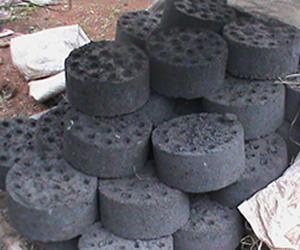Mak Students Make Carbonized Briquettes from Waste
 Submitted by jbimokola on
Submitted by jbimokola on

Six students are making carbonized briquettes from food peelings, corn cobs, saw dust and charcoal dust. The students from the Department of Environmental Management under Makerere University College of Agricultural and Environment studies formed their own organization that is doing this project.
Due to limited space within Makerere University, the students dealt with local people in Namuwongo and Makindye where the community offered them land.
Carbonized briquettes are blocks of compressed biomass material such as farming waste, charcoal dust or waste dust. They are made from materials that have undergone carbonization such as charcoal dust. Carbonization is done manually by heating the raw materials in less or no oxygen.
Gordon Yosefi Mwesigwa, one of the students who made the briquettes says briquette making involves a series of processes. He says that the process takes a great deal of effort and is a messy process that “if you are one of the people seeking high paying dirty jobs, then, you may consider making briquettes to sell to your neighborhood”.
They mix the paper with the saw dust and enough water so that the mix will hold together when it is squeezed. They then make a bottle mold, cut off the upper quarter of a soda bottle and make drainage holes in the bottom and lower sides by burning holes with a hot wire.
The carbonization process of briquettes drives off volatile compounds to leave more or less pure carbon. The saw dust are first screened to remove contaminants and oversized particles. They are then dried to moisture content of about 8-10% in the impulse dryer with hot air that is generated using wood waste. The fairly dry dust is then fed into a screw type briquetter for compacting into briquettes. The density of the briquettes formed is around 1200kg/m. The briquettes that leave the briquetting machine are hot and slightly roasted outside.
The retort method involves passing wood through a series of hearths or ovens. It is a continuous process where wood constantly enters one end of a furnace and charred material leaves the other.
Once the briquettes are made, they are cleaner and smokeless than the lump charcoal and that’s the reason many people like them because one is able to save money.
Nakileza Bob, a lecturer at the Department of Environment Management says the briquettes perform better over much longer periods, compared to other fuels like firewood and charcoal.
Raymond Acaye, a student on the team says the aim of their project was motivated by a series of trainings that they attended from different organizations for example from Enterprise Uganda, Incubation Center and Renewable Businesses.
He however says they first carried out a survey to assess their potential customers, raw materials suppliers and prospective competitors in Ggaba-Kasanga, Kampala. They were able to establish the customers and the briquettes are doing well on the market.
Musa Ngago, a worker at Warid family at Kubiri-Wandegeya says that they were very interested in supplying saw dust to the initiative because most of the time, the saw dust generated is either dumped or burnt.
Courtesy Photo
- Log in to post comments
- 1346 reads
